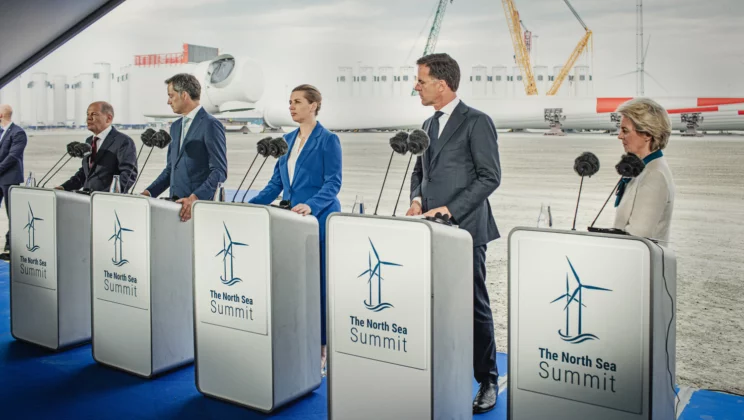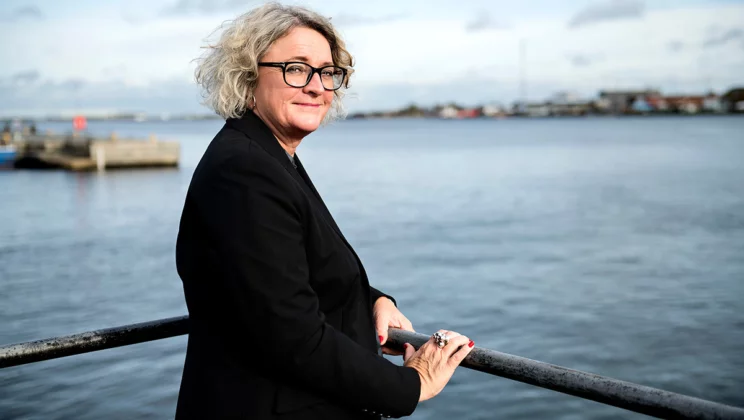The Esbjerg Declaration of 18 May constitutes a landmark decision for the energy supply of Northern Europe as a whole. While it will require a dramatic change of pace in the installation of wind turbines, three key players are optimistic. “Following the signing of the declaration on 18 May, the train is moving faster and with greater power than ever before,” says Director General of the Danish Energy Agency, while Danish Shipping believes a ketchup effect will help achieve the targets. They both emphasise that ports will be playing an even more prominent role than previously. Not least Port Esbjerg.
It was all smiles and handshakes when European Commission President Ursula von der Leyen announced that the participants had reached agreement at the North Sea Summit held on 18 May at the port of Esbjerg. Danish Prime Minister Mette Frederiksen and her opposite numbers from Germany, Belgium and the Netherlands then signed the Esbjerg Declaration, which is highly ambitious by any standards. Together, the countries have set the combined targets of producing 65 GW of offshore wind by 2030 and increasing capacity to at least 150 GW by 2050. This can provide 230 million European households with green electricity. The project will require investments in excess of DKK 1,000 billion.
But signing a declaration is one thing. Making it happen is another matter.
“It’s time to suit up,” as Kristoffer Böttzauw, Director General of the Danish Energy Agency, puts it.
The Danish Energy Agency advises the Danish government on energy supply issues, and once the political decisions have been made, the Agency plays a key role in managing the projects.
Before the Esbjerg summit, plans were already in place for a significant expansion of Danish offshore wind power by 2030. Since then, the government has announced that it wants to establish another 4 GW offshore wind power, bringing the current 2.3 GW to 12.9 GW, equivalent to a five-fold increase in the current capacity.
This may sound like an almost insurmountable task, but Kristoffer Böttzauw points out that the work has long since been set in motion. The fact is that the Esbjerg Declaration is an addition to already existing initiatives. It has been decided to construct two energy islands, to establish an offshore wind farm by the Danish island of Hesselø with a capacity of 0.8–1.2 GW and, according to the agreement on the 2022 national budget, to build an additional 2 GW offshore wind capacity, and lastly, successful bidders have been found for the Thor Offshore Wind Farm and the Vesterhav Syd and Vesterhav Nord nearshore wind farms. The three wind farms will produce a total of 1.35 GW of offshore wind.
“So we’ve actually come quite far already,” says Böttzauw.
And he expects that a decision will be made before the summer holidays to put out a tender for another 4 GW to be built by 2030.
“We still have some distance to go, and it may seem overwhelming. But less daunting, after all, when we look at all the things that have already been set in motion. Some 6–7 GW have been planned, and the energy island in the North Sea is underway,” says Böttzauw.
According to plans, the energy island to be located in the North Sea will deliver up to 10 GW when fully implemented.
Where to locate the remaining GW will be determined in the planned, so-called, fine screening to be carried out until 2025, which will map the potential and opportunities in the coming years. It will also identify potential sites for building more offshore wind farms, Böttzauw explains.

Kristoffer Böttzauw, Director General of the Danish Energy Agency, believes that even though we are far from the finish line, we have come far in relation to reaching the goals of the Esbjerg Declaration.
A changed mindset
While a good deal of the Danish gigawatts is on track, Böttzauw also finds that the Esbjerg Declaration of 18 May has, in itself, resulted in a changed mindset.
“This decision has created ripples. It is not only the European Commission making an announcement. Four Heads of Government have now committed themselves and each other and made it part of their national decision-making processes. I have met managers from countries all over the world who are excited about it. The train is moving even faster and with greater power than ever before,” says Böttzauw.
Energinet operates the transmission systems for electricity and gas in Denmark and is in charge of preparing the offshore and onshore power grids for the massive upgrade. And they recognise that the Esbjerg Declaration heralds something new and makes a real difference.
“We’re seeing other countries reaching out now. We’re negotiating with both the Dutch and the Germans about collaborating on the first energy island, and we’re about to land a partnership deal with Belgium for the North Sea. We can feel that the entire industry is thinking – this time, they really mean it,” says Hanne Storm Edlefsen, Vice President for Energy Islands in Energinet.
Energinet is currently engaged in a market dialogue with cable and transformer station suppliers and is surveying and mapping the seabed where the cables are to be placed to ensure they will not be on top of an archaeological find or in porous seabed.
Shipping companies: Expect a ketchup effect
Shipping companies will help supply labour for much of the work to be done. Their trade organisation, Danish Shipping, is also very excited and believes it is a feasible goal.
“This has been underway for some years now, and a number of wind turbine installation vessels are under construction. But the 18 May Declaration gives an incentive to invest, so now more vessels will be ordered. It may take a few years before they are ready, but we’re dealing with a ketchup effect when so many wind farms are put out to tender all at once. The shipping companies are ready to deliver,” says CEO Anne H. Steffensen.
Hope of speeding up the process
Danish Prime Minister Mette Frederiksen announced in connection with the summit on 18 May that too much time had been wasted waiting for offshore wind permits. She therefore urged the EU to introduce a fast-track procedure to speed up the process. At present, it typically takes about seven or eight years from a decision is made to erect an offshore wind farm until the wind turbines have been installed at sea and produce green electricity.
But this will not change the process for the time being.
“It’s still not possible to decide on an offshore wind project and then have a wind farm ready within five years. The capacity we want for 2030 has to be decided now. On the positive side, no other countries in Europe, as far as we know, have a faster process than we do in Denmark,” says Kristoffer Böttzauw, Director General of the Danish Energy Agency.
And the Agency hopes to speed up this process in the longer term. They are discussing with the industry how to make the processes smoother. In some cases, offshore wind has gone from being subsidy driven to generating revenue for the government, so the market has also matured.
“It’s our ambition to be able to build wind farms in less than eight years, but no matter what we do, the projects take time. We’ve got to take into consideration bird seasons and similar factors, so we can’t just bulldoze ahead,” says Böttzauw.
The ongoing fine screening will help speed up the process as it will identify suitable sites, thereby avoiding areas with poor seabed conditions and breeding habitats of birds.

At The North Sea Summit, Prime Minister Mette Frederiksen announced that too much time had been wasted waiting for offshore wind permits.
Esbjerg to play key role
When the pace of the green transition accelerates, Böttzauw argues that ports will play an even more prominent role. Both because they will provide the space for production sites that have to be sited close to sea transport to avoid overland transport of components. And because it will be natural to place Power-to-X facilities close to port environments where production facilities are already located.
“The ports are already at the centre of offshore wind, and if anyone needs convincing the best place in the world to see this for yourself is in Esbjerg. This is the embodiment of what offshore wind is capable of. Even as you step out of your car at the port, you’ll experience a major wow effect. And now the ports become even more important,” says Böttzauw, who have been standing at the port several times with politicians that have been blown away by the sight of vessels and turbine components.
Anne H. Steffensen, CEO of Danish Shipping, agrees that the ports will become even more important. The expansion of offshore wind capacity and the current situation in Ukraine both increase the importance of the ports.
“This means that we’ll see lots of infrastructure expansions and lots of new jobs at the ports. We’ll need bunkering facilities, Power-to-X, more jobs will emerge and a lot more installation vessels. The ports will play a crucial role,” she says.
According to Steffensen, Esbjerg is in a very strong position in this process as the port is already a hub.
“The assignments won’t land in our lap. But Esbjerg has the knowhow, space and labour,” she adds.
Steffensen also expects there will be a need to build facilities at the port for storing green fuels to be used by the shipping industry going forward. Esbjerg has room for these facilities so vessels can dock at the port and fill up with the green fuels.

CEO of Danish Shipping, Anne H. Steffensen, is convinced that the importance of the ports is increasing - both due to the expansion of offshore wind and the current situation in Ukraine.
Bottlenecks will appear
Steffensen argues that time is the biggest challenge. In this connection, the difficult weather conditions in the North Sea are a factor, and she also believes it may be difficult to obtain sufficient labour.
“It’s a sensitive small market. Shipping companies face a challenge recruiting enough masters as well as able-bodied and ordinary ship’s assistants. This is difficult already, and as things get busier, it’ll become even more difficult. Especially since the wind turbine industry often prefers Danish seafarers, who can engage in direct dialogue with customers,” she says.
But Danish Shipping can recruit people from other countries, and multiple nationalities are already working on board the ships.
Böttzauw’s primary concern is whether the supply chains can keep up. Whether enough supply vessels can be procured, and whether the feasibility studies can be completed.
“To be honest, I’ve got my doubts, even though I’m an optimist. Will the supply chains be sufficiently flexible? And also, being a government representative, I worry about the price. If the free market isn’t working, will I get a good price?” says Böttzauw.
At Energinet, space is the greatest concern. But the solution is to cooperate, according to Hanne Storm Edlefsen, Vice President for Energy Islands.
“So many activities will be going on for years to come that we’ve got to share the space. Therefore, it’s important that we join forces to succeed. It’s no use outcompeting each other, for instance by focusing only on laying the cables without thinking about installing the wind turbines,” says Edlefsen.
Thousands of jobs in Esbjerg
The ambitious offshore wind plans will mean thousands of jobs. For every gigawatt of offshore wind built, 14,600 full-time equivalent (FTE) jobs will be generated in Denmark, according to a report published in 2020 by Danish Energy and Danish Shipping. In other words, the report shows that the rollout of 12.9 GW of offshore wind by 2030 will generate around 188,000 FTE jobs, although this number may be lower due to economies of scale.
Steffensen regards this report as the most thorough investigation of the effect on employment. And these are the figures that both industry experts and the government refer to.
“We’ll see considerable job growth. Both in terms of the number of people employed at sea, the number of vessels and much more. We don’t have any specific numbers, but a rough estimate would be that the number of members working in this area will increase by 50 per cent by 2030 as a result of the 18 May declaration, if the ambitions are turned into reality. This is significant,” says Steffensen.
She sums up the time ahead as follows:
“The more, the sooner, the better. We’ll need enormous amounts of offshore wind power to produce the fuels we need for sailing, flying and operating heavy transport vehicles. It’s a gigantic task, but we’re well underway.”
Go to overview

